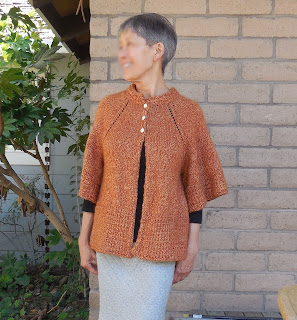
I recently finished this flared raglan style cardigan, using Rowan Silk Twist. The pattern is improvised. I wanted to experiment with the placement of the raglan increases. In the standard raglan sweater, at least for me, the stitches are divided up such that when I separate the body from the sleeves, I end up with fairly fitted sleeves and a fitted bust line area. Usually this happens when the length of the slanted increases is about 8 inches. In this case, I wanted the increases to continue much further down so that the armhole would be much wider. I've seen a ready-to-wear sweater in a shop with this sort of fit and I know I've also seen a few patterns with this style. My idea was to end up with something that sort of fits like a poncho for the upper part of the body, but is much easier to wear because it has sleeves further down. I also had such success with a stand-up collar and an i-cord front with this cardigan that I wanted to try that again. I don't know if it ended up very poncho-like, but I'm very happy with the result. It's very easy to wear and the silk twist yarn is not overly warm.

This sweater is one of those one-size-fits-most sort of garments. For those who are interested, here are my rough notes on this pattern.
- I divided the body and sleeve sections into quarters for the raglan placement. I cast on aiming for a neckline opening of about 17 inches. I did not cast on all the neckline stitches at once -- I did a few rows at the front neckline where I cast on some additional stitches so that the front neckline is lowered. I also did a couple of short rows on the back area to raise the back neckline a bit.
- After that, it's your standard raglan increases with 8 stitches added on every round done with YOs. I stopped the increases when the raglan length was about 12 inches. At this point, I have wide armholes and the split happens way below the bust line.
- I continued increases on the body every 4 rows for about 3 inches, then every 6 rows for about 3 inches. At that point, I changed over to a broken rib pattern for the bottom section. I did one more set of increases in the rib section about 1.5 inches in, and then just knit with straight sides to the bottom.
- For the sleeves, I increased every 4 rows about 2 inches, then every 6 for an inch, then changed to the rib pattern and threw in one more set of increases about 1.5" into the rib.
- The front edges are finished with a 4-stitch i-cord. The collar is knitted by picking up stitches at the neckline and then folded over and attached on the inside to give it a good stand-up look.
